MITSUBISHI MONTERO 1998 Service Manual
Manufacturer: MITSUBISHI, Model Year: 1998, Model line: MONTERO, Model: MITSUBISHI MONTERO 1998Pages: 1501, PDF Size: 25.81 MB
Page 581 of 1501
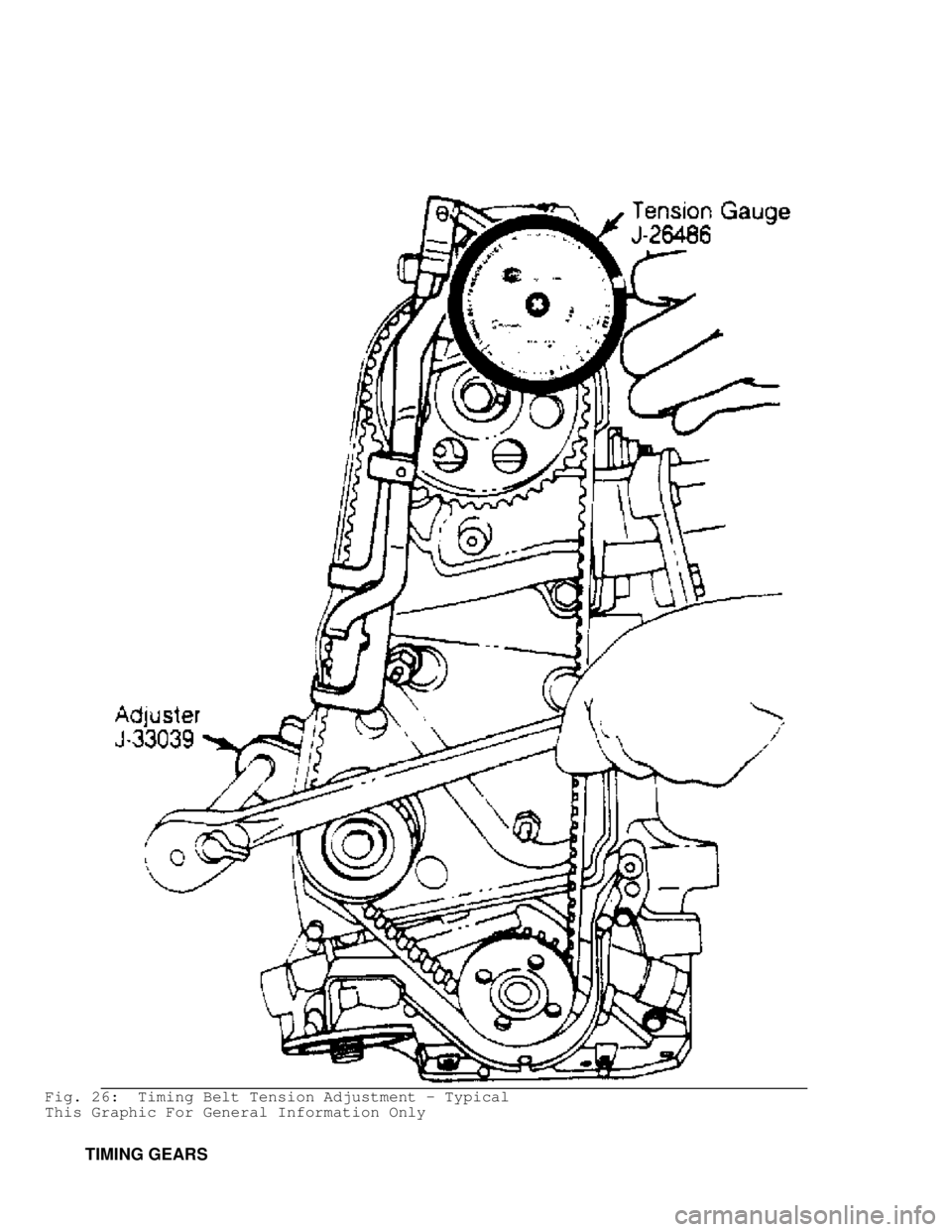
Fig. 26: Timing Belt Tension Adjustment - Typical
This Graphic For General Information Only
TIMING GEARS
Page 582 of 1501
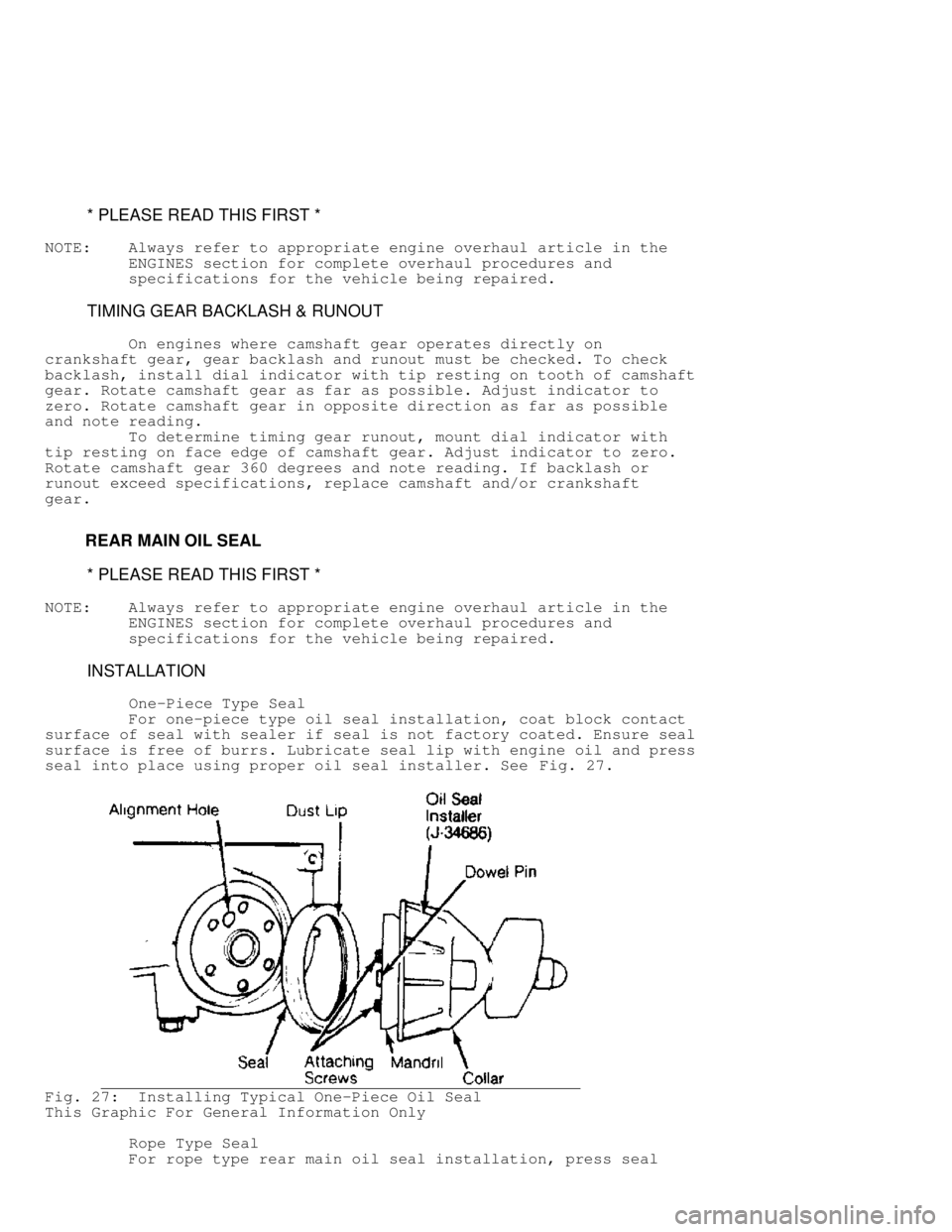
* PLEASE READ THIS FIRST *
NOTE: Always refer to appropriate engine overhaul article in the
ENGINES section for complete overhaul procedures and
specifications for the vehicle being repaired.
TIMING GEAR BACKLASH & RUNOUT
On engines where camshaft gear operates directly on
crankshaft gear, gear backlash and runout must be checked. To check
backlash, install dial indicator with tip resting on tooth of camshaft
gear. Rotate camshaft gear as far as possible. Adjust indicator to
zero. Rotate camshaft gear in opposite direction as far as possible
and note reading.
To determine timing gear runout, mount dial indicator with
tip resting on face edge of camshaft gear. Adjust indicator to zero.
Rotate camshaft gear 360 degrees and note reading. If backlash or
runout exceed specifications, replace camshaft and/or crankshaft
gear.
REAR MAIN OIL SEAL
* PLEASE READ THIS FIRST *
NOTE: Always refer to appropriate engine overhaul article in the
ENGINES section for complete overhaul procedures and
specifications for the vehicle being repaired.
INSTALLATION
One-Piece Type Seal
For one-piece type oil seal installation, coat block contact
surface of seal with sealer if seal is not factory coated. Ensure seal
surface is free of burrs. Lubricate seal lip with engine oil and press
seal into place using proper oil seal installer. See Fig. 27.
Fig. 27: Installing Typical One-Piece Oil Seal
This Graphic For General Information Only
Rope Type Seal
For rope type rear main oil seal installation, press seal
Page 583 of 1501
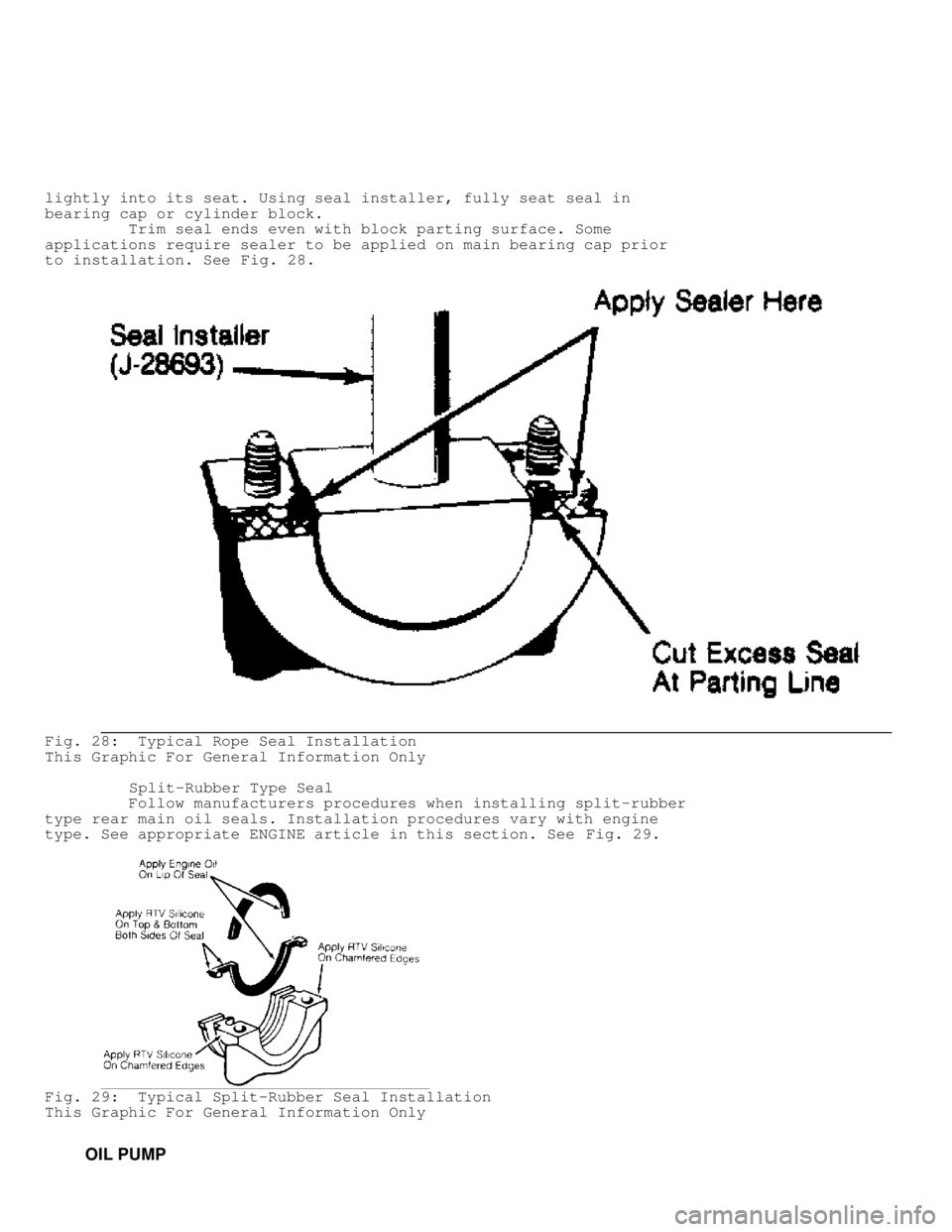
lightly into its seat. Using seal installer, fully seat seal in
bearing cap or cylinder block.
Trim seal ends even with block parting surface. Some
applications require sealer to be applied on main bearing cap prior
to installation. See Fig. 28.
Fig. 28: Typical Rope Seal Installation
This Graphic For General Information Only
Split-Rubber Type Seal
Follow manufacturers procedures when installing split-rubber
type rear main oil seals. Installation procedures vary with engine
type. See appropriate ENGINE article in this section. See Fig. 29.
Fig. 29: Typical Split-Rubber Seal Installation
This Graphic For General Information Only
OIL PUMP
Page 584 of 1501
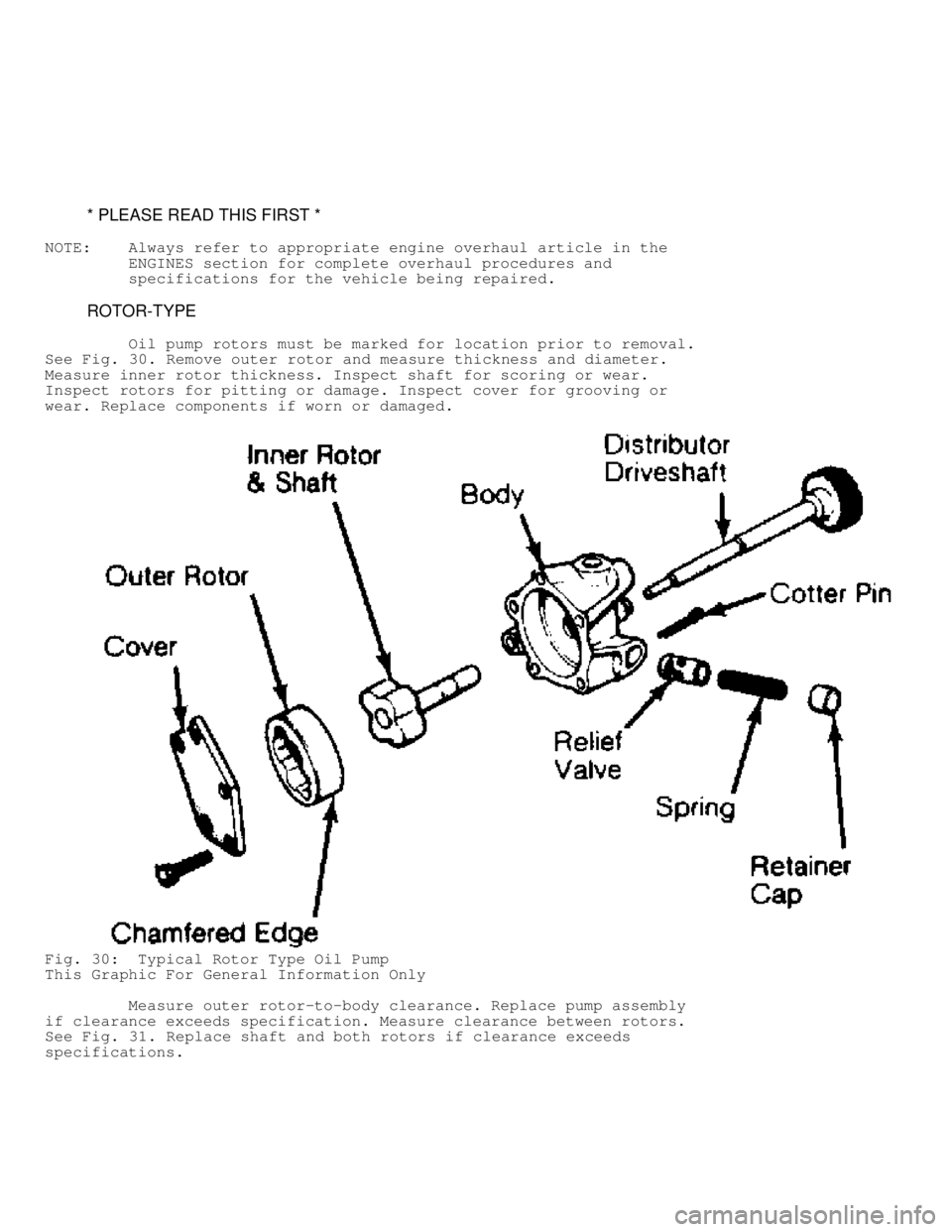
* PLEASE READ THIS FIRST *
NOTE: Always refer to appropriate engine overhaul article in the
ENGINES section for complete overhaul procedures and
specifications for the vehicle being repaired.
ROTOR-TYPE
Oil pump rotors must be marked for location prior to removal.
See Fig. 30 . Remove outer rotor and measure thickness and diameter.
Measure inner rotor thickness. Inspect shaft for scoring or wear.
Inspect rotors for pitting or damage. Inspect cover for grooving or
wear. Replace components if worn or damaged.
Fig. 30: Typical Rotor Type Oil Pump
This Graphic For General Information Only
Measure outer rotor-to-body clearance. Replace pump assembly
if clearance exceeds specification. Measure clearance between rotors.
See Fig. 31 . Replace shaft and both rotors if clearance exceeds
specifications.
Page 585 of 1501
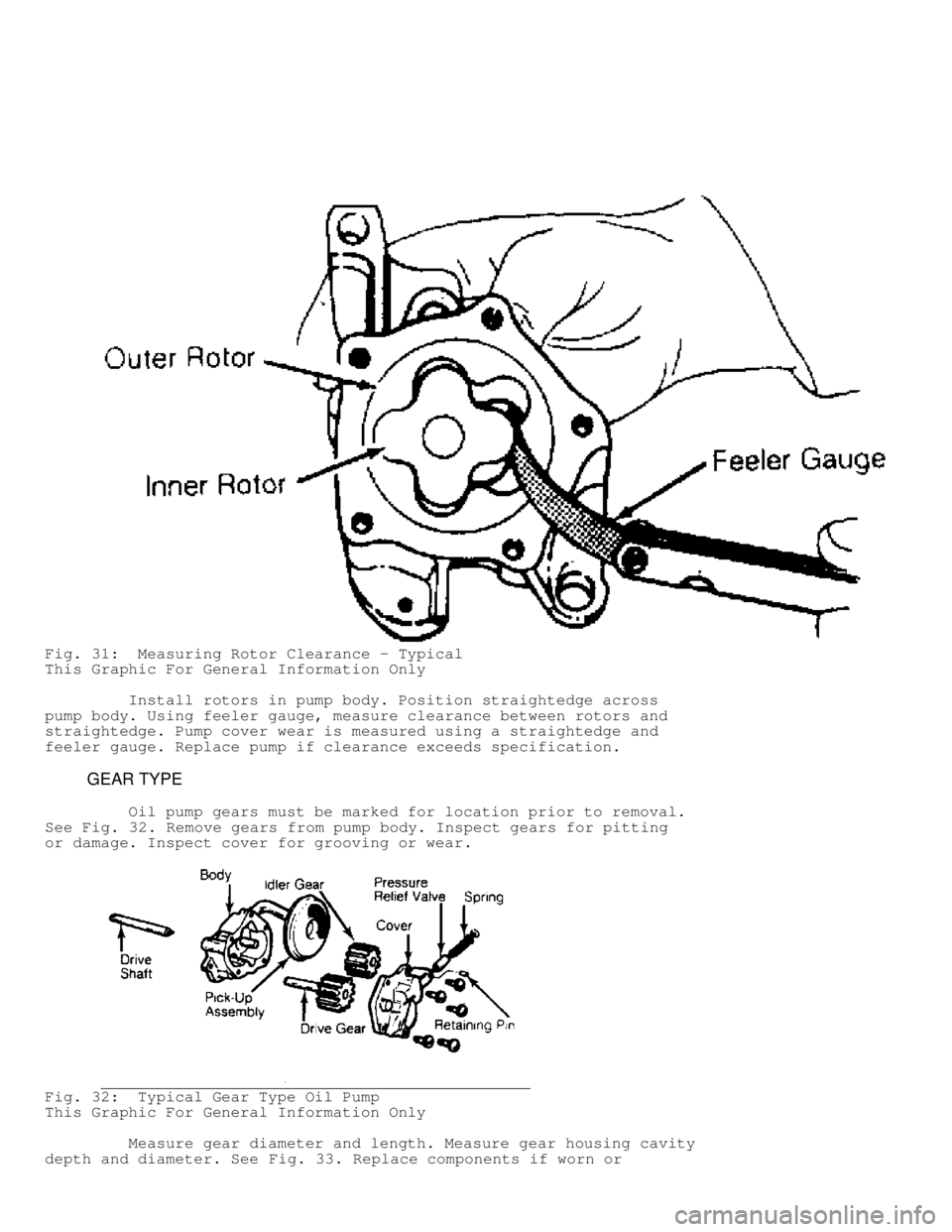
Fig. 31: Measuring Rotor Clearance - Typical
This Graphic For General Information Only
Install rotors in pump body. Position straightedge across
pump body. Using feeler gauge, measure clearance between rotors and
straightedge. Pump cover wear is measured using a straightedge and
feeler gauge. Replace pump if clearance exceeds specification.
GEAR TYPE
Oil pump gears must be marked for location prior to removal.
See Fig. 32 . Remove gears from pump body. Inspect gears for pitting
or damage. Inspect cover for grooving or wear.
Fig. 32: Typical Gear Type Oil Pump
This Graphic For General Information Only
Measure gear diameter and length. Measure gear housing cavity
depth and diameter. See Fig. 33. Replace components if worn or
Page 586 of 1501
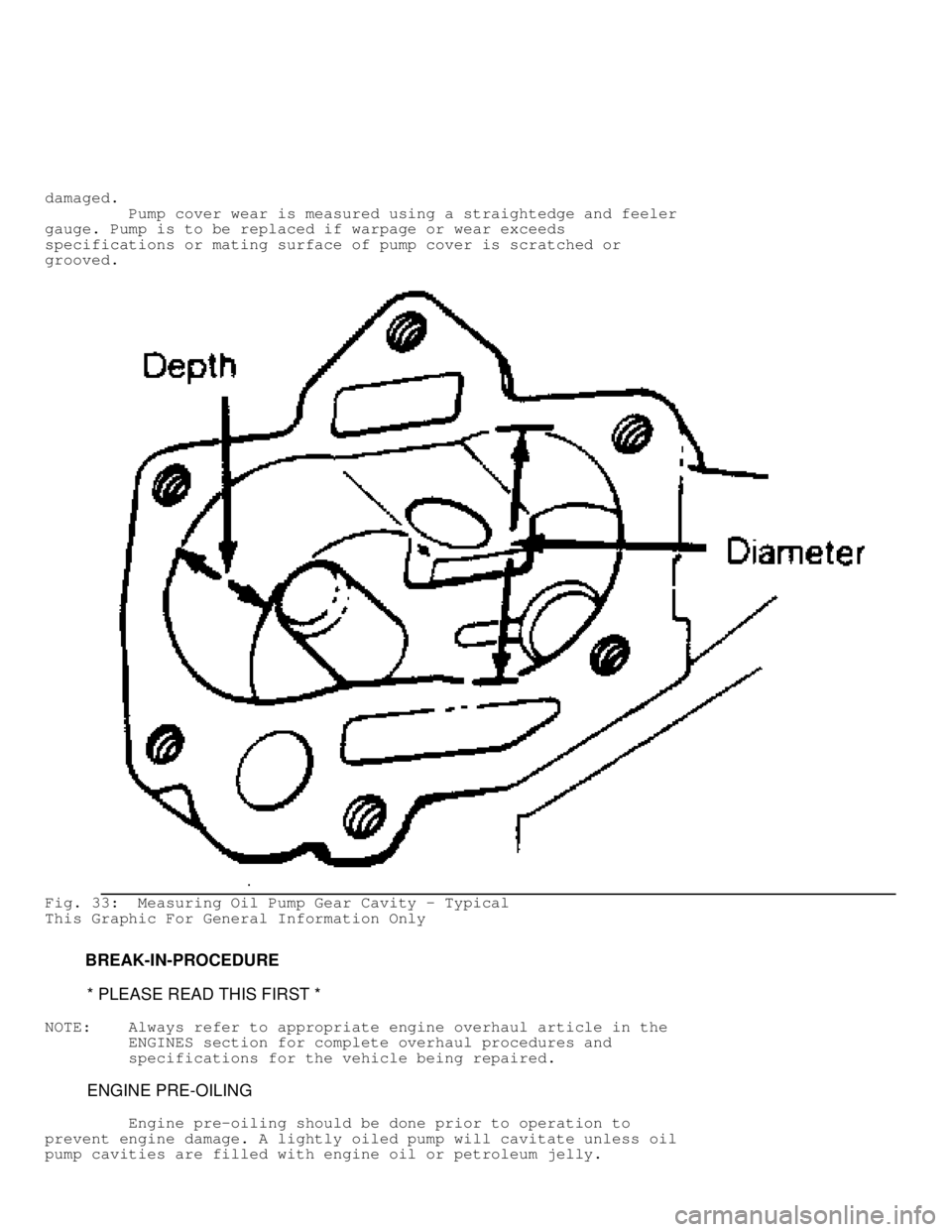
damaged.
Pump cover wear is measured using a straightedge and feeler
gauge. Pump is to be replaced if warpage or wear exceeds
specifications or mating surface of pump cover is scratched or
grooved.
Fig. 33: Measuring Oil Pump Gear Cavity - Typical
This Graphic For General Information Only
BREAK-IN-PROCEDURE
* PLEASE READ THIS FIRST *
NOTE: Always refer to appropriate engine overhaul article in the
ENGINES section for complete overhaul procedures and
specifications for the vehicle being repaired.
ENGINE PRE-OILING
Engine pre-oiling should be done prior to operation to
prevent engine damage. A lightly oiled pump will cavitate unless oil
pump cavities are filled with engine oil or petroleum jelly.
Page 587 of 1501

Engine pre-oiling can be done using pressure oiler (if
available). Connect pressure oiler to cylinder block oil passage
such as oil pressure sending unit. Operate pressure oiler long enough
to ensure correct amount of oil has filled crankcase. Check oil level
while pre-oiling.
If pressure oiler is not available, disconnect ignition
system. Remove oil pressure sending unit and replace with oil pressure
test gauge. Using starter motor, rotate engine starter until gauge
shows normal oil pressure for several seconds. DO NOT crank engine
for more than 30 seconds to avoid starter motor damage.
Ensure oil pressure has reached the most distant point from
the oil pump. Reinstall oil pressure sending unit. Reconnect ignition
system.
INITIAL START-UP
Start the engine and operate engine at low speed while
checking for coolant, fuel and oil leaks. Stop engine. Recheck coolant
and oil level. Adjust if necessary.
CAMSHAFT
Break-in procedure is required when a new or reground
camshaft has been installed. Operate and maintain engine speed between
1500-2500 RPM for approximately 30 minutes. Procedure may vary due to
manufacturers recommendations.
PISTON RINGS
Piston rings require a break-in procedure to ensure seating
of rings to cylinder walls. Serious damage may occur to rings if
correct procedures are not followed.
Extremely high piston ring temperatures are produced obtained
during break-in process. If rings are exposed to excessively high RPM
or high cylinder pressures, ring damage can occur. Follow piston ring
manufacturer's recommended break-in procedure.
FINAL ADJUSTMENTS
Check or adjust ignition timing and dwell (if applicable).
Adjust valves (if necessary). Adjust carburetion or injection idle
speed and mixture. Retighten cylinder heads (if required). If
cylinder head or block is aluminum, retighten bolts when engine is
cold. Follow the engine manufacturer's recommended break-in procedure
and maintenance schedule for new engines.
NOTE: Some manufacturer's require that head bolts be retightened
after specified amount of operation. This must be done to
prevent head gasket failure.
Page 588 of 1501

* ENGINE SYSTEMS UNIFORM INSPECTION GUIDELINES *
1998 Mitsubishi Montero
GENERAL INFORMATION
Engine Performance and Maintenance Motorist Assurance Program
Standards For Automotive Repair
All Makes and Models
INTRODUCTION TO MOTORIST ASSURANCE PROGRAM (MAP)
CONTENTS
Motorist Assurance Program (MAP)
OVERVIEW OF MOTORIST ASSURANCE PROGRAM
OVERVIEW OF SERVICE REQUIREMENTS AND SUGGESTIONS
Engine Assemblies
CYLINDER HEAD ASSEMBLIES
LONG BLOCK ASSEMBLIES
SHORT BLOCK ASSEMBLIES
Engine Components
ACCELERATOR PEDAL POSITION SENSORS
ACCESSORY BELTS
ACCESSORY PULLEYS
ACTUATORS
AIR CONDITIONING CYCLING SWITCHES
AIR CONDITIONING PRESSURE SENSORS
AIR DUCTS AND TUBES
AIR FILTER ELEMENTS
AIR FILTER GASKETS
AIR FILTER HOUSINGS AND GASKETS
AIR FUEL RATIO SENSORS
AIR INJECTION CONTROL SOLENOIDS
AIR PLENUMS
AIR PUMP BELTS
AIR PUMPS (ELECTRIC-DRIVEN)
AIR TUBES
ASPIRATOR, CHECK AND DECEL VALVES
BAFFLES
BALLAST PRIMARY SUPPLY RESISTOR WIRES
BALLAST RESISTORS AND PRIMARY SUPPLY RESISTOR WIRES
BAROMETRIC PRESSURE SENSORS
BATTERIES
BATTERY CABLES, WIRES AND CONNECTORS
BATTERY CONNECTORS
BATTERY TRAYS AND HOLD DOWN HARDWARE
BATTERY WIRES
BELT-DRIVEN AIR PUMPS
BELT IDLER ASSEMBLIES (ACCESSORY AND CAM BELTS)
BELT TENSIONERS (ACCESSORY AND CAM BELTS)
BOOST CONTROL MECHANISMS
CAMSHAFT POSITION SENSORS
CARBURETORS AND CHOKES
CASTING CORE PLUGS AND EXPANSION PLUGS
CHARGE AIR COOLERS "INTERCOOLERS" (CAC)
CHECK VALVES
CHOKES
Page 589 of 1501

CLUTCH PEDAL POSITION SWITCHES
COLD START INJECTORS
CONNECTORS
COOLANT
COOLANT RECOVERY TANKS
COOLING FAN MOTOR MODULES
COOLING FAN MOTOR RELAYS AND MODULES
COOLING FAN MOTOR RESISTORS
COOLING FAN MOTOR SENSORS AND SWITCHES
COOLING FAN MOTOR SWITCHES
COOLING FAN MOTORS
CRANKSHAFT POSITION SENSORS
DECEL VALVES
DEFLECTORS
DIP STICKS AND TUBES
DIP STICK TUBES
DISTRIBUTOR ADVANCES AND RETARDERS (MECHANICAL AND VACUUM)
DISTRIBUTOR BOOTS AND SHIELDS
DISTRIBUTOR CAPS
DISTRIBUTOR RETARDERS (MECHANICAL AND VACUUM)
DISTRIBUTOR ROTORS
DISTRIBUTOR SHIELDS
DISTRIBUTORS
EARLY FUEL EVAPORATION VALVES (HEAT RISER ASSEMBLIES)
EGR COOLERS
EGR EXHAUST MANIFOLD PASSAGES
EGR INTAKE AND EXHAUST MANIFOLD PASSAGES
EGR PLATES AND COOLERS
ELECTRONIC SPARK CONTROL MODULES
ELECTRONIC TRANSMISSION CONTROL DEVICES
ELECTRONIC TRANSMISSION FEEDBACK DEVICES
ENGINE COOLANT TEMPERATURE SENSORS
ENGINE COOLING SYSTEMS
ENGINE COVERS (OIL PAN, VALVE COVER, TIMING COVER)
ENGINE OIL
ENGINE OIL CANISTERS
ENGINE OIL COOLERS (EXTERNAL)
ENGINE OIL DRAIN PLUGS AND GASKETS
ENGINE OIL FILTERS AND CANISTERS
ENGINE OIL GASKETS
ENGINE OIL PRESSURE GAUGES (MECHANICAL)
EVAPORATIVE EMISSION (EVAP) CANISTER FILTERS
EVAPORATIVE EMISSION (EVAP) CANISTER PURGE DEVICES
EVAPORATIVE EMISSION (EVAP) CANISTERS
EVAPORATIVE EMISSION (EVAP) FEEDBACK DEVICES
EXHAUST GAS RECIRCULATION DEVICES
EXHAUST GAS RECIRCULATION FEEDBACK DEVICES
EXPANSION PLUGS
FAN CONTROL SENSORS
FUEL
FUEL ACCUMULATORS AND DAMPERS
FUEL AND COLD START INJECTORS
FUEL DAMPERS
FUEL DELIVERY CHECK VALVES
FUEL DISTRIBUTORS (BOSCH CIS)
FUEL FILLER NECKS AND RESTRICTORS
FUEL FILTERS
FUEL INJECTORS
FUEL LEVEL SENDERS7
FUEL PRESSURE REGULATORS
FUEL PUMPS (IN-TANK AND EXTERNAL, ELECTRICAL OR MECHANICAL)
FUEL RAILS
FUEL RESTRICTORS
Page 590 of 1501

FUEL TANKS
GAS CAPS
GASKETS
GROMMETS (VALVE COVER)
HARMONIC DAMPERS
HEATER CONTROL VALVES
HEATER CORES
HOSE AND TUBE COUPLERS, CONNECTORS AND CLAMPS
HOSE CLAMPS
HOSE CONNECTORS
HOSE COUPLERS
HOSES AND TUBES (FUEL LINES, RADIATOR, VACUUM, BY PASS,
HEATER, RECOVERY TANK AND OIL COOLERS)
HOUSINGS
IDLE AIR CONTROLS
IDLE SPEED CONTROL ACTUATORS
IGNITION BOOTS
IGNITION COIL TOWERS
IGNITION COILS
IGNITION CONTROL MODULES (ICM)
IGNITION SWITCHES
IGNITION TERMINALS
IGNITION WIRES, BOOTS, COIL TOWERS AND TERMINALS (SECONDARY)
IN-TANK FUEL STRAINERS
INERTIA FUEL SHUT-OFF SWITCHES
INTAKE AIR TEMPERATURE SENSORS
INTAKE MANIFOLDS
INTERCOOLERS
KNOCK SENSORS
LIQUID VAPOR SEPARATORS
MANIFOLD ABSOLUTE PRESSURE (MAP) SENSORS
MASS AIR FLOW (MAF) SENSORS
METAL AIR MANIFOLDS AND PIPES
METAL AIR PIPES
MIX CONTROL SOLENOIDS
MOTOR MOUNTS
O-RINGS, GASKETS, SEALS AND SPRING LOCKS
O2 SENSORS
OIL PRESSURE SENDING UNITS
OIL PUMP PICK-UP SCREENS
OIL PUMPS
PARK NEUTRAL POSITION SWITCHES
PCV BREATHER ELEMENTS
PCV ORIFICES
PCV VALVES
PICK-UP ASSEMBLIES (INCLUDES MAGNETIC, HALL EFFECT AND
OPTICAL)
POWER STEERING PRESSURE SENSORS
POWERTRAIN CONTROL MODULES (PCM) AND PROM
POWERTRAIN CONTROL PROM
PRESSURIZED EXPANSION TANK CAPS
RADIATOR CAPS AND PRESSURIZED EXPANSION TANK CAPS
RADIATOR FAN BLADES
RADIATOR FAN CLUTCHES
RADIATORS
ROLL OVER VALVES
SEALING COMPOUNDS
SEALS
SECONDARY AIR INJECTION SYSTEM MANAGEMENT DEVICES
SENSORS AND ACTUATORS
SHROUDS, BAFFLES AND DEFLECTORS
SPARK PLUGS
SPRING LOCKS